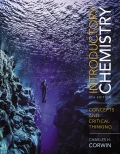
Concept explainers
(a)
Interpretation:
Whether combustion is a physical or a chemical change is to be stated.
Concept introduction:
The change in the physical property of a substance is known as a physical change, which is reversible in nature.
The change in the chemical property of a substance is known as a chemical change, which is irreversible in nature.
(b)
Interpretation:
Whether vaporization is a physical or a chemical change is to be stated.
Concept introduction:
Chemical reactions are the rearrangement of atoms, molecules, or ions to form other chemical substances. Chemical changes are of two types: physical change and chemical change.
The change in the physical property of a substance is known as a physical change, which is reversible in nature.
The change in the chemical property of a substance is known as a chemical change, which is irreversible in nature.
(c)
Interpretation:
Whether sublimation is a physical or a chemical change is to be stated.
Concept introduction:
Chemical reactions are the rearrangement of atoms, molecules, or ions to form other chemical substances. Chemical changes are of two types: physical change and chemical change.
The change in the physical property of a substance is known as a physical change, which is reversible in nature.
The change in the chemical property of a substance is known as a chemical change, which is irreversible in nature.
(d)
Interpretation:
Whether oxidation is a physical or a chemical change is to be stated.
Concept introduction:
Chemical reactions are the rearrangement of atoms, molecules, or ions to form other chemical substances. Chemical changes are of two types: physical change and chemical change.
The change in the physical property of a substance is known as a physical change, which is reversible in nature.
The change in the chemical property of a substance is known as a chemical change, which is irreversible in nature.
Want to see the full answer?
Check out a sample textbook solution
Chapter 3 Solutions
EBK INTRODUCTORY CHEMISTRY
- Indicate whether the following changes of physical state require heating or cooling. (a) gas to liquid (b)liquid to solidarrow_forwardA substance has a definite shape and definite volume. What is the state of the substance?(a) solid (b) liquid (c) gasarrow_forwardState whether the following will sink or float when dropped into water. (a) wax (d = 0.90 g/cm³) (b) marble (d = 3.5 g/cm³arrow_forward
- is the following ingredients, can use as household cleaning materials? specify their use as household cleaning materials. garlic- onion- salt- vinegar- What properties they possessed to be considered as cleaning products.“Ingredients as Household Cleaning Products”arrow_forwardIdentify two forms of energy that are involved in each of the following energy conversions relating to an automobile. (a) lead–acid battery making electricity (b) electricity turning a starter motor (c) starter motor turning a flywheel (d) gasoline exploding into hot gasesarrow_forwardIdentify each of the diagrams shown here as an elementor a compound.arrow_forward
- State the term that applies to each of the following changes of physical state: (a) Snow changes from a solid to a liquid. (b)Gasoline changes from a liquid to a gas. (c) Dry ice changes from a solid to a gas.arrow_forwardWhich of the following is best characterized as a heterogeneous mixture? Group of answer choices (a) Air (b) Sandy Dirt (c) An aqueous solution of NaCl (d) Electrum (an alloy of gold and silver) (e) Clear Diamondarrow_forwardThe images represent three samples of nitrogen dioxide, which is the pollutant responsible for the brown color of the atmospheric pollution. At high temperatures, nitrogen dioxide decomposes to nitrogen monoxide and oxygen gas. Use the particulate model below to answer the following questions. (a) (b) (c)arrow_forward
- Classify each of the following as a physical change or a chemical change. (a) Touching a lit candle to hydrogen soap bubbles gives an explosion. (b)Heating water in a flask produces moisture on the glass. (c) Combining two colorless solutions gives a yellow solid. (d) Pouring vinegar on baking soda produces gas bubbles.arrow_forwardis paint a compound or elementarrow_forwardClassify each change as physical or chemical. (a) the explosion of gunpowder in the barrel of a gun(b) the melting of gold in a furnace(c) the bubbling that occurs when you mix baking soda andvinegar(d) the bubbling that occurs when water boilsarrow_forward
 World of ChemistryChemistryISBN:9780618562763Author:Steven S. ZumdahlPublisher:Houghton Mifflin College Div
World of ChemistryChemistryISBN:9780618562763Author:Steven S. ZumdahlPublisher:Houghton Mifflin College Div World of Chemistry, 3rd editionChemistryISBN:9781133109655Author:Steven S. Zumdahl, Susan L. Zumdahl, Donald J. DeCostePublisher:Brooks / Cole / Cengage Learning
World of Chemistry, 3rd editionChemistryISBN:9781133109655Author:Steven S. Zumdahl, Susan L. Zumdahl, Donald J. DeCostePublisher:Brooks / Cole / Cengage Learning

